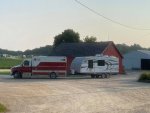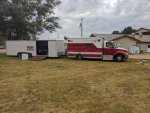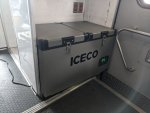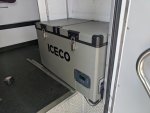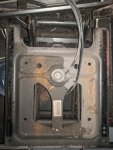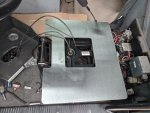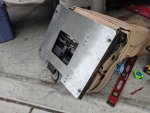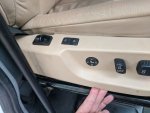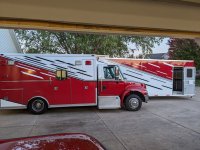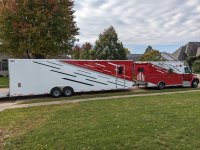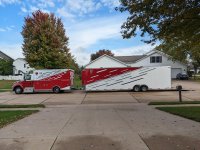A couple things I have done modification wise:
After a couple longer trips, it became apparent that the noise was going to be an issue. Not that you notice it so much on short trips (it's loud, like any MDT), but after 2+ hours on the road and switching off the engine your ears definitely let you know that you've been doing bad things to them. Another semi-related problem is the factory stereo is terrible. We put in a bluetooth speaker, but that too had to be turned up so high to be heard over the truck that it just made the problem worse. I considered gutting the cab and putting sound deadening everywhere, which is a fair amount of cost and a ton of work. And after that, I'd want to upgrade the stereo... New head unit, speakers, which would probably mean modifying panels to get ones that aren't comically small, etc etc. All doable, but a big project to be sure, and would cost at least a couple grand all said and done plus time. Instead, I had a bit of an epiphany after my wife got a pair of noise cancelling bose headphones that were surprisingly reasonably priced. If I could figure out a way to integrate those somehow, we could kill 2 birds with 1 stone. All that would be required would be some kind of intercom system, preferably with a line in for music!
Seemed simple, but like many things didn't turn out to be quite so easy.
- My first thought was to see what was on the market for emergency crews, you often see firefighters with headphone setups for communication (and hearing protection) on the loud fire trucks. Didn't end up finding out anything easy / affordable there, and most of the new stuff has gone wireless which I wanted to avoid. I'd rather deal with a wire and a plug far into the future, than mess with batteries, pairing, interference on channels, and whatever else... not to mention the cost, not cheap.
- My second idea was to use an aviation intercom unit like pilots use in small (and large) aircraft. I even discovered I had a friend who was getting into flying who had an old portable one given to him that I could play with! Long story short, while designed to do exactly what we want to do, aviation is it's own world. Standards were developed 80 years ago and never changed, even though the rest of the world moved on. As a result, it turns out the impedance used on their headphones is from the early days of the telephone switchboard headsets, which everyone else in the world has long since moved on from. This goes for the speakers in the headset, but more critically the type of microphone as well. I tried making adapters, playing with various amps and things, but it isn't a simple straightforward conversion between the two, and it just didn't work properly. By the time I could get the mic to trigger from talking, it was blowing out my eardrums with feedback. Of course, we could have bought aviation headsets, but anything aviation is needlessly expensive... active sound cancelling headsets can easily run 1k each. Not to mention, by using normal headsets, we have the added benefit of being able to use them for all the normal uses (flying, at my computer, whatever else), so diving into the aviation setup was a no-go.
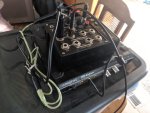
- My third, and ultimately successful idea, was to use a motorcycle intercom. Now, the problem with these, is two fold: They also aren't designed for typical headphone / mics, but rather a mic and speaker planted in the helmet, and each manufacturer likes to make proprietary stuff. Also, about 10 years or so ago, they all went wireless, and finding old school wired units that weren't well used and built into an old motorcycle was a bit challenging. I ended up finding an old new stock Autocom Kit 300 on Ebay and taking a gamble on that. At this point, I just wanted this idea to work on principle, and was ready to roll the dice. This kit of course uses (more or less) proprietary connectors to the headsets, but already was setup for various aux inputs (music, phone, GPS, etc) which all used the standard 1/8" headphone jacks. Also important, is it had individual volume adjustments for driver, passenger, various inputs, mic trigger sensitivity, etc. because it is designed to be used with motorcycles which is a VERY noisy and variable environment depending on the bike, wind direction, speed of travel... In any case, all the hard stuff was done, and best of all the unit is very compact and set up for 12v power. All that was left to do was to make some adapters from 1/8" headphone/mic combo jacks to the proprietary ones the kit uses. Thankfully, the kit came with enough things that I had some cables I could sacrifice without hacking up the wiring in the unit itself. After some testing and ordering a few parts it was time to try it out...
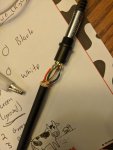
Success! The impedances and things the mic and speakers used in the kit that once wired up to a standard pair of headphones, and some small adjustments to various levels, it just works! My wife and I can listen to music at a comfortable (frankly, rather quiet) volume and hear it cleanly, and speak normally to each other at will. The most I've had to do was speak up a little bit at times to trigger the mic to kick in, but once it does you can speak very quietly and it stays active until you stop. The noise canceling does a great job of knocking down the road noise and turbo whine, to where now when we stop for gas and take the headphones off, the truck is shockingly loud even at idle. It has made traveling SO much nicer, and I think we arrive much more rested as well. And to those who (rightfully) might be concerned about the over the ear headphones in a moving vehicle, they really only cancel out the regular noises... steady patterns like the engine, road noise, etc. Other noises seem to come through just fine (emergency sirens, honks, etc.) because the noise canceling system isn't great at those anyway. And because our ears are adjusted to the low volume environment, the db loss from the over the ear foam itself isn't enough to prevent us hearing things we need to hear.
All in all, I took care of both the noise issue of the truck, and listening to music at a reasonable volume, for under $200 for the autocom and fittings. He headphones run about $220 each (Bose QC 35 gaming headsets) but sometimes are on sale for less, and as I said before we use them for lots more than in the ambulance. It's all hardwired in so no issue with interference. We generally just listen to music from our phones, but we could run an input from another source (such as a radio) if we wanted, although I don't see that happening. I really don't see a need to worry about sound insulation in the cab anymore other than I do feel a bit bad for the dog who for some reason refuses to wear headphones.
